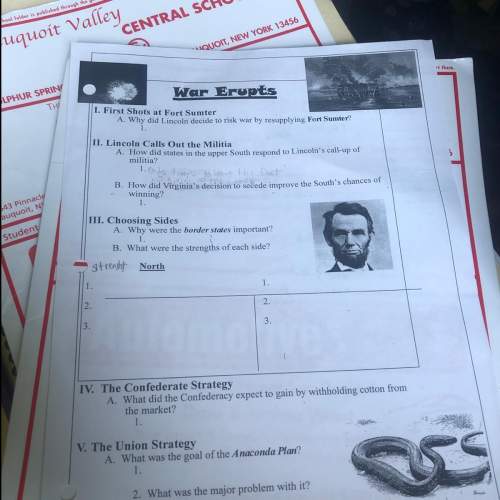
History, 19.11.2020 19:10 kyaslaven9791
NOT ASKING FOR HELP, THESE ARE THE ANSWERS
1. What was the primary motive behind John C. Calhoun's position concerning the role of the United States in the War of 1812?
He hoped for the addition of territory, siding with the War Hawks in the call for war against Great Britain. CORRECT
He wished for peace above all else, urging caution and negotiation with the British to solve differences.
He hoped to win more votes in the New England region and was solidly against the war with Great Britain.
He desired a renewed alliance with France in supporting a declaration of war against Great Britain.
2. How did the response to the growth of the abolitionist movement contribute to increased sectionalism in the United States?
Abolitionists began to move South in attempt to impose their values on large plantations owners, which had the opposite effect of angering them further. CORRECT
Southern leaders in Congress successfully passed the "gag rule" that prohibited discussion of abolition in Congress, further angering supporters of the cause.
Southerners who did not own slaves became more willing to hear the position of the abolitionists, which created a divide between Southerners.
Although there were no abolitionists living in the South, Southerners increasingly feared the growth of the abolitionist movement in the North.
3. What was South Carolina's position on the issue of protective tariffs?
South Carolina felt tariffs were a necessary step to protect workers in the North.
South Carolina believed, as acts of Congress, tariffs should be enforced fully.
South Carolina saw tariffs as beneficial only to northern manufacturers and workers. CORRECT
South Carolina concluded tariffs would benefit the South as the price of cotton rose.
4. How was South Carolina affected by the tariffs and their position on them?
Tariffs led to a surge in nationalism throughout the South, especially South Carolina, so tariffs were supported.
Cotton sales in countries targeted by the tariffs increased as prices for imported goods increased, so tariffs were supported.
Countries targeted by tariffs saw an increase of membership in abolitionist groups as a result, so tariffs were opposed.
They were forced to pay higher prices for the goods they imported from Europe, so tariffs were opposed. CORRECT
5. How did the position of John C. Calhoun on the nullification controversy contribute to secession from the Union?
Calhoun believed secession was appropriate only if approved by the federal government. CORRECT
His support for states' rights later grew into a big part of the argument for secession.
As vice president, he argued that states were bound by federal law, which was supreme.
He argued that nullification was flawed and infuriated those who wished to secede.

Answers: 3


Another question on History

History, 21.06.2019 23:30
How did the beliefs of the roman catholics differ from the eastern orthodox form of christianity?
Answers: 1

History, 22.06.2019 05:00
The occupies the territory between the coastal plain in the appalachian mountains. a. piedmont. b. tidewater. c. delaware valley. d. outer banks.
Answers: 2

History, 22.06.2019 05:30
When this was published in early 1776, many american colonists became convinced that they should act to form a new kind of nation independent from the rule of britain's "cruel" courts
Answers: 1

You know the right answer?
NOT ASKING FOR HELP, THESE ARE THE ANSWERS
1. What was the primary motive behind John C. Calhoun's...
Questions

History, 17.11.2020 22:50





History, 17.11.2020 22:50

Mathematics, 17.11.2020 22:50

English, 17.11.2020 22:50

Mathematics, 17.11.2020 22:50


Mathematics, 17.11.2020 22:50


Biology, 17.11.2020 22:50


Mathematics, 17.11.2020 22:50


Mathematics, 17.11.2020 22:50

Health, 17.11.2020 22:50


English, 17.11.2020 22:50




